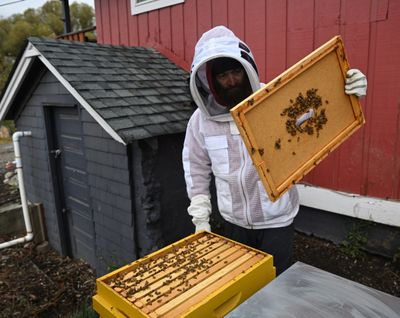Ask Dr. Unvierse: Why do bees make honey?

Washington State University
Dr. Universe: Why do bees make honey? – Gabby, 9, Kansas
Dear Gabby,
As a science cat, I don’t stir honey into my tea or drizzle it on my biscuits. I don’t have taste receptors for sweet things. Honey doesn’t have a taste to me.
But my human friends gobble up the honey made by the Washington State University bees. I asked my friend Rae Olsson why bees make that sticky stuff in the first place. Olsson is an insect scientist.
It turns out honey is the way honey bees store food for the winter.
“Just like we store food in our refrigerators and pantries, bees turn nectar from flowers into honey, so it doesn’t spoil,” Olsson said.
Worker bees collect all that nectar from flowers in the spring and summer. It’s a sugary liquid flowers make to entice bees and other pollinators to visit the flowers. While they slurp up the nectar from different flowers, they also pick up some of the flower pollen and spread it to other flowers. That’s how flowering plants make seeds.
Bees take some of the pollen home to make a protein-rich food called bee bread. But it’s the nectar that’s super important for grown up bees.
“It’s the main source of food for adult bees,” Olsson said. “However, nectar can spoil if it isn’t preserved correctly. It’s sort of like how fruit juice might get moldy if you leave it out too long.”
So, honey bees use a tongue-like organ called a proboscis to suck up nectar like a straw. They swallow it, but only a little bit goes to their actual stomach. Most of it goes to a special pouch called a honey stomach.
Inside the honey stomach, the nectar mixes with bee saliva. Proteins in the saliva start changing the nectar into honey.
While that’s happening, the bee flies back to the colony. Then it barfs the partially-processed nectar from its honey stomach into another bee’s mouth. Moving nectar or other food from one bee’s mouth to another bee’s mouth is called trophallaxis.
The nectar passes from bee to bee in the colony, mixing with more and more bee saliva. Eventually, when it’s almost honey, a bee spits the thick liquid into a beeswax cell. Then the bees turn around and flap their wings super-fast. That evaporates all the extra water from the honey.
Once it’s perfect, the bees seal the cell with a little cap of wax. When it gets cold, and there aren’t flowers around to make nectar, bees can pop open a beeswax cell and slurp up the honey.
Bees make way more honey than they need. That’s why people can keep bees and harvest their extra honey. Because of how it’s made, honey is one of the only foods that pretty much never spoils. Scientists have even found honey that’s thousands of years old and still yummy.
Even I can tell that’s a sweet find.
Sincerely,
Dr. Universe
Adults can help kids submit a question at askdruniverse.wsu.edu/ask.